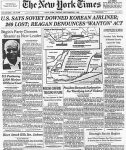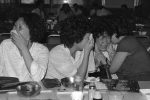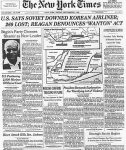
On September 1st 1983 a civilian airliner, Korean Air Flight 007, disappeared over the Sea of Japan. The Boeing 747-230B was flying from New York City to Seoul, via a refuelling stop in Alaska. There were 269 people on board, the majority of them South Koreans and Americans. Investigations soon revealed that Flight 007 was shot down by a Russian missile, probably while flying in international airspace. It had crashed off the southern tip of Sakhalin Island, a Russian possession to the north of Japan. All passengers and crew were killed. The Korean Air disaster, as it became known, prompted horror and outrage around the world. It was strongly condemned by United States president Ronald Reagan, who described it as a “crime against humanity… violating every concept of human rights”. The shooting down of Flight 007 marked a low point in US-Soviet relations. According to some commentators, it brought the two countries closer to war than at any point since the Cuban missile crisis.
Flying was a dangerous activity during the Cold War, due to the political tensions of the era, coupled with air defence systems and heightened states of alert. This was particularly true when flying in or near border regions. Between 1950 and 1970 no less than 15 US military planes were shot down by Soviet forces, while three Soviet planes were shot down by the Americans. The vast majority of these incidents in the Asia-Pacific region: off Russia’s Asian coastline or around the islands of Japan. There were also attacks and near misses in Europe. In March 1953 a Czech-piloted Russian MiG jet shot down an American F-84 flying over German airspace. In September 1958 an American C-130 reconnaissance plane, carrying six crewmen and 11 intelligence agents, was shot down in Soviet territory by four MiGs; all six crew were confirmed dead but the fate of the intelligence agents was never revealed. In January 1964 three American crewmen died when their training plane was shot down by a Soviet MiG over East Germany.

Attacks on civilian planes were less common, though they occasionally happened. In July 1954 Chinese-piloted Soviet fighters shot down a Cathy Pacific DC-4 flying to Hong Kong, killing ten people. Bulgarian MiG pilots shot down an Israeli civilian flight in July 1955, after it mistakenly veered into Bulgarian airspace; 58 passengers and crew were killed. There were also several takedowns of civilian planes by revolutionary and proxy forces in the Middle East and Africa. Portentously, Soviet forces had previously shot down a Korean Air Lines flight, the incident occurring in April 1978. On this occasion, the plane, a Boeing 707 flying from Paris to Seoul over the North Pole, had mistakenly entered Soviet airspace and failed to respond to radio and visual warnings. The Korean plane was struck by a Soviet missile and disabled but not destroyed. It made a forced landing on a frozen lake. All but two of the 109 passengers and crew survived and were quickly rescued by Russian helicopters.

Korean Air Flight 007 took off from New York City late on August 30th 1983, headed for the South Korean capital Seoul via a refuelling stop in Anchorage, Alaska. The flight carried 246 passengers and 23 crew members. Most of the passengers were Korean (76), American (62) and Japanese (28). Among the passenger list was Larry McDonald, a Democratic member of the US House of Representatives, travelling to Seoul for the 30th anniversary of a Cold War defence treaty. After refuelling in Anchorage Flight 007 took off and headed south-west towards its destination. With the Boeing’s autopilot engaged, the pilots believed they were following a legitimate flight path over international waters – however, a number of technical mishaps, coupled with pilot misjudgement, meant the plane was actually headed towards Siberia. Flight 007’s course took it over Kamchatka, a mountainous peninsula peppered with Soviet radar facilities and military bases. It crossed over Kamchatka and on towards Sakhalin Island, another Soviet territory.
“The United States and its NATO allies have never shot down even a Soviet or Russian intelligence aircraft because the threat posed by such intrusions does not justify so draconian a response. The Soviet destruction of KAL 007 makes sense militarily and politically only if the Soviets believed an attack on their territory was imminent.”
Peter Vincent Pry, author
Soviet commanders had spotted the Korean jet as it approached Kamchatka, classifying it as “unidentified”. They suspected the plane was an American intelligence gathering aircraft, which had been active in the region. The Soviets continued to track the 747 as it overflew Sakhalin, scrambling four fighters to intercept. Flight 007 failed to respond to radio calls and did not spot warning shots fired by the Soviet jets. When the Korean plane climbed to a higher altitude, purely by coincidence, the Soviet pilots interpreted it as an evasive measure. Receiving an order to bring the plane down, they fired two air-to-air missiles at the Boeing. The missile detonation did not destroy the plane immediately but caused significant damage, resulting in a loss of control in the cockpit. The plane remained in the air for several minutes, first screaming skyward, then began a series of slow downward spirals. It crashed into the ocean near Moneron Island, off the southern tip of Sakhalin. All 269 on Flight 007 died, most likely after several terrifying minutes.

What followed was equally as diabolical. The Soviets launched an immediate search and rescue operation in the area – yet Moscow denied shooting down the plane or knowing its whereabouts. It would be five days before the Soviets acknowledged their role in downing the Korean plane. American, South Korean and Japanese ships were dispatched to search the area for bodies, debris and evidence. Their search attempts were continually hampered by interference from Soviet warships. This included the intimidation of civilian vessels, removing or sabotaging equipment, cutting moorings, sending decoy signals, orchestrating near collisions and even initiating missile ‘lock-ons’ against US Navy ships. The joint American-Korean search team found comparatively little evidence – a surprise, given the considerable size of Flight 007. Very few bodies, body parts or pieces of luggage were found, either by the surface team or civilian divers. It appeared to searchers that the crash site had already been picked over by Soviet teams. The lack of bodies and luggage at the crash site gave rise to several conspiracy theories.

The shooting down of a civilian airliner by a military plane invoked a furious reaction, both in the US and from other Western leaders. On September 5th Ronald Reagan delivered a nationwide address and condemned the Soviets, both for the attack and their subsequent response. The US and its Cold War ally Japan released audio recordings of the Soviet pilots and officers on the ground. Transcripts of these discussions suggested that an attack order had been given by Soviet commanders on the ground, despite scant information on the plane and uncertainty from Soviet pilots. Soviet leaders maintained the official line, asserting that Flight 007 was being used by the Central Intelligence Agency (CIA) to overfly and gather information from secret military bases. The Soviet Union faced swift recriminations, including a United Nations resolution condemning its actions (later vetoed by Moscow) and the cancellation of Russian airline Aeroflot’s licence to operate in the US.
The attack on Flight 007 soured US-Soviet relations for months, if not years. The Soviet Union was not the last Cold War superpower to mistakenly shoot down a civilian jet, however. In July 1988 an American naval cruiser, USS Vincennes, was on duty in the Persian Gulf when it fired two surface-to-air missiles at an incoming plane. According to the testimony of the Vincennes’ crew, the plane was believed to be an Iranian F-14A fighter flying with hostile intent. In reality, it was Iran Air Flight 655, an Airbus A300 travelling to Dubai with 290 civilian passengers and flight crew onboard. The Iranian plane was struck by an American missile and obliterated. All onboard were killed. Washington explained the attack as a valid response to a legitimate threat: an unidentified and uncontactable plane flying in a known war zone. There had been several attacks on US ships in the Persian Gulf in the previous 18 months. Like the Soviets in 1983, the US refused to issue a formal apology to Iran, though Washington later agreed to pay $US61.8 million to compensate the families of victims.

1. The Korean Air disaster refers to an incident in September 1983 when Soviet fighter jets shot down a Korean civilian plane, killing all 269 people on board.
2. Attacks on aircraft, both civilian and military, were not uncommon in the Cold War, due to elevated political tensions and the readiness by air defence systems.
3. Korean Air Flight 007 was shot down by MiG fighters after straying into Soviet airspace, north of Japan. Its incorrect flight path was caused by technical glitches and pilot error.
4. The Soviet response was evasive. Moscow at first denied any involvement in the crash or any awareness of its location. Later, Soviet ships interfered with the joint US-Japanese search effort.
5. The attack on Flight 007 heightened tensions between Moscow and Washington. President Ronald Reagan condemned it as a “crime against humanity” and authorised a range of recriminations against the Soviets.

Transcripts from Korean Air Flight 007
Ronald Reagan on the global response to Flight 007
Content on this page is © Alpha History 2018-23. This content may not be republished or distributed without permission. For more information please refer to our Terms of Use.
This page was written by Jennifer Llewellyn and Steve Thompson. To reference this page, use the following citation:
J. Llewellyn et al, “The Korean Air disaster”, Alpha History, accessed [today’s date], https://alphahistory.com/coldwar/korean-air-disaster/.
